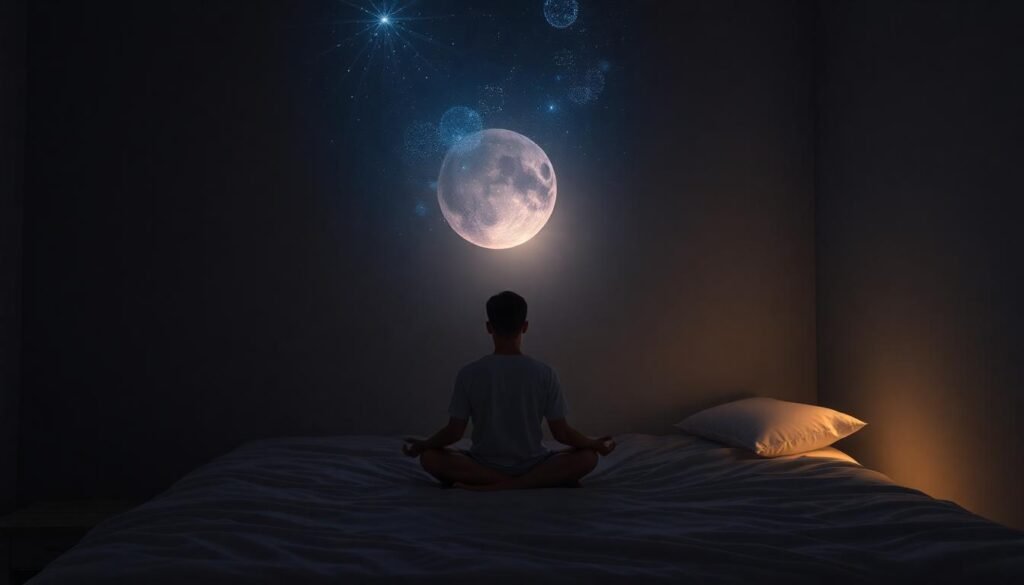Getting a night of deep sleep is essential for restoring the body, preserving memory, and balancing mood. Proper rest strengthens the immune system, regulates hormones, and improves mental health, preventing conditions such as anxiety, depression, and chronic illness. However, insomnia and restless nights have become increasingly common in our pressure-filled, overstimulated routines.
Meditation emerges as a natural, accessible, and effective tool to counter this scenario. Meditative practices help relax the body, slow the mind, and create a state conducive to restorative sleep. In this article, I present five meditation techniques that are easy to incorporate into a nighttime routine and explain how each one can support deeper and more restorative sleep.
Why Meditation Improves Deep Sleep

Meditation has a direct impact on the biological and psychological processes that control sleep. A regular practice slows mental activity, reduces stress stored in the body, and activates internal relaxation systems. When I meditate before bed, I notice clear effects on both my body and my mood upon waking. Science supports this too: meditation contributes to deep sleep and reduces nighttime awakenings, promoting more restorative nights. Here are the main mechanisms behind this positive effect.
Stress and Anxiety Reduction
Stress is one of the biggest enemies of deep sleep. When the body is in a state of alertness, with high cortisol levels (the stress hormone), the brain stays vigilant, making full relaxation impossible. Meditation, by slowing down thought patterns and encouraging conscious breathing, directly helps lower cortisol.
- Practices like deep breathing and mindfulness reduce heart rate and relax the muscles
- Recent studies suggest meditation can be even more effective than melatonin supplements for better sleep
- Regular meditators report lower anxiety and greater nighttime calm
When I experience less anxiety, my body responds more naturally to the sleep process. With a quieter mind, it’s easier to enter the deepest stages of sleep.
Stimulating the Parasympathetic Nervous System
The parasympathetic nervous system acts like a “biological brake,” calming the body after a day full of stimuli. Meditation is known to stimulate this system, triggering physiological responses that promote relaxation, such as:
- Lowering blood pressure
- Reducing respiratory rate
- Intense muscle relaxation
- Producing neurotransmitters like serotonin and GABA that promote calm and sleep
In a busy routine filled with digital stimulation, intentionally activating the parasympathetic system makes a real difference. When I meditate, I feel tension leaving my body and my breathing becoming lighter—both essential for a natural transition into deep sleep.
Supporting Hormonal Balance
Beyond calming the mind, meditation also plays a proven role in regulating the circadian rhythm—the biological clock responsible for the sleep-wake cycle. This regulation promotes the natural release of melatonin, a key hormone for initiating and maintaining deep sleep. The most noticeable effects include:
- Increased melatonin production at night
- Fewer awakenings and reduced insomnia
- Shorter sleep latency (sometimes reducing time to fall asleep by up to 50%)
With consistent practice, I experience a more stable sleep cycle, with fewer interruptions and a real sense of rest upon waking.
Benefits of Consistent Practice
The benefits of meditation for sleep grow stronger over time. People who maintain a nightly meditation habit report improvements not only in sleep quality but also in mental and emotional health:
- Better mood and less irritability in the morning
- Reduced dependence on medications or supplements
- Greater resilience to daily stress
- A sense of mental clarity and energy throughout the day
I’ve experienced this myself and heard it from other practitioners: peaceful nights become part of everyday life, making deep sleep more accessible—without side effects and with clear improvements in overall well-being.
5 Deep Sleep Meditation Techniques for a Peaceful Night

For those seeking restful sleep, there are specific meditation techniques designed to calm both the mind and body, promoting deeper nights of rest. Each technique offers a unique approach and benefits, so it’s worth trying the one that fits your style—or even combining them for enhanced results.
Mindfulness Before Bed
Mindfulness is one of the simplest and most accessible practices to begin with. Its essence lies in staying present, without judgment, and not clinging to passing thoughts.
Step-by-step:
- Sit or lie down comfortably in bed
- Close your eyes and rest your hands gently on your abdomen
- Begin observing your breath without trying to control it
- When thoughts arise (about the day or worries), acknowledge them and gently return your focus to the breath
- Notice your body touching the bed, the sounds around you, the temperature of your skin—no rush
Mindfulness doesn’t require you to stop thinking—only to accept the present moment. This exercise slows mental activity, calms your heart rate, and promotes inner peace. People who practice regularly report falling asleep faster and waking up less during the night.
4-7-8 Breathing to Slow Down
The 4-7-8 breathing technique is a powerful ally for those who struggle to “switch off” at night. It quickly reduces anxiety and is highly effective at relaxing both the body and mind before sleep.
How to practice:
- Sit or lie down comfortably
- Close your mouth and inhale quietly through your nose for 4 seconds
- Hold your breath for 7 seconds
- Exhale slowly through your mouth for 8 seconds
- Repeat the cycle 4 times
This method helps regulate the nervous system, quiet racing thoughts, and release tension. Within minutes, I feel my muscles relax and my mind settle—an ideal practice for those who experience a racing heart or occasional insomnia.
Progressive Muscle Relaxation
Progressive muscle relaxation targets tension built up throughout the day. It involves consciously tensing and releasing different muscle groups.
How it works:
- Lie down comfortably and close your eyes
- Take a deep breath, tense one muscle group (e.g., feet) for five seconds, then release completely as you exhale
- Gradually move upward: feet, calves, thighs, abdomen, hands, arms, shoulders, neck, and face
- Feel the contrast between tension and release
This sequence generates a growing sense of lightness. It’s especially helpful for those who feel physically tense or wake up rigid from worry. Besides calming the body, it helps identify and consciously release hidden tension.
Guided Meditation for Falling Asleep
Guided meditations are audio-based practices led by a narrator. All you need to do is listen and follow the voice. This format is especially useful for those who find it hard to meditate on their own, as the narration keeps focus on the breath, body sensations, or soothing visualizations.
Tips for choosing:
- Choose voices that feel calming and comforting
- Look for sleep-specific recordings—they usually have a slower pace and ideal length
- Explore popular apps like Insight Timer, Calm, and Spotify, which offer free guided sessions
- Try different durations to see what works best for your routine
This technique is practical, accessible, and perfect for beginners or those seeking quick support before sleep.
Peaceful Visualization
Visualization involves imagining peaceful places or scenarios—such as beaches, forests, or flower fields. The goal is to fill your mind with calming images and shift focus away from anxious thoughts.
How to practice:
- Lie down and close your eyes
- Picture a safe and beautiful place, vividly imagining the colors, sounds, smells, and sensations like a soft breeze or flowing water
- Stay present in this place, breathing slowly and deeply as if you were really there
Visualization is especially effective for those dealing with racing thoughts. It helps reprogram the mind toward calmness and gently transitions you into sleep. For me, it feels like pressing a mental “off switch.”
Each of these techniques offers powerful results and can be adapted to your nightly needs. Whether you’re seeking inner silence, physical release, or simply a break from worry, there’s a meditation practice to guide you into deep, restorative sleep.
How to Integrate Meditation into Your Night Routine

When I include meditation in my evening ritual, I feel a noticeable difference in both body and mind. It’s not just about doing a technique—it’s about creating a set of habits that welcome sleep from the very start of the night. Integrating meditation into a nighttime routine requires attention to your environment, consistency in timing, and strategies to keep the habit going—even when life gets busy. With small shifts and gentle discipline, this new pattern can be both simple and enjoyable.
Creating a Supportive Environment for Meditation
I always begin by adjusting the space. A cozy environment helps the body understand it’s time to slow down, just like dimming the lights signals to the brain that the day is ending.
Some helpful tips:
- Soft lighting: I use warm lamps or small candles, avoiding any bright light
- Minimal noise: I close windows to block out external sounds and, when needed, use white noise or calming sounds to settle the mind
- Ideal temperature: Between 18°C and 21°C keeps the body comfortable for meditation and sleep
- Relaxing scents: A diffuser with lavender or chamomile sets the tone—just a hint, so it doesn’t become overwhelming
- No distractions: I keep my phone out of reach and silence all notifications
Setting up your space this way sends a clear signal to your brain that it’s time to wind down. It significantly improves the quality of both your meditation and sleep.
Best Time and Duration for Nighttime Meditation
When choosing when to meditate, I’ve found that consistency matters more than the exact hour. The key is to pick a regular moment, ideally 30 to 60 minutes before bedtime.
Here are some practical adjustments:
- Avoid meditating right after a heavy meal so digestion doesn’t interfere
- Start with 5 to 15 minutes if you’re new—the goal is relaxation, not pressure
- If you’re more experienced, extending to 20 minutes deepens the effect and promotes more relaxation
Over time, repeating this ritual at a consistent time teaches your body to associate it with sleep, making it easier to fall asleep and wake up refreshed.
Long-Term Strategies for Sticking to the Habit
The biggest challenge is doing it night after night—especially when life gets hectic or motivation dips. To make meditation a fixed part of my evening, I created some simple tricks:
- Set reminders: I use phone alarms or post visible notes in my bedroom
- Have a “mini ritual”: I link meditation with brushing my teeth or having tea—this automatic sequence helps me stay on track
- Stay flexible: If I’m tired, I choose a short guided audio and sit instead of lying down—no need for perfection
- Track small wins: Observing how sleep or mood improves reinforces the habit’s value
- Release guilt: If I skip a night, I return the next evening with kindness and no self-judgment
These strategies turn meditation into a rewarding form of self-care. Soon, I start missing it when I don’t do it.
Overcoming Initial Challenges
At first, meditating daily can feel tough. The body fidgets, the mind races, and the pressure to “do it right” can backfire. The secret is acceptance—not perfection.
Tips to ease the start:
- Begin small: Even 3 to 5 minutes help. Only increase time when it feels natural
- Use guided meditations: They keep focus and reduce the feeling of getting lost in thought
- Don’t expect silence: A busy mind is normal in the beginning. With time, your brain learns to quiet down
- Celebrate progress: Recognizing your steps toward peaceful nights helps you keep going
With patience, these practices take root. Sleep improves. Bedtime becomes a gentle invitation to well-being.
Conclusion
With regular use of these meditation techniques, I create a safe space for body and mind to unwind, promoting calmer nights and a more balanced mood in the morning. Practicing them strengthens my awareness and transforms my relationship with sleep.
By setting aside just a few minutes each night for mindful care, I notice deep changes in my energy, motivation, and ability to handle daily challenges. Each step—no matter how small—supports a positive cycle: deep sleep brings renewed vitality into every part of life.
Restorative sleep isn’t a luxury. It’s a real possibility when I commit to caring for myself. Thank you for reading this far, and I invite you to try these meditations for yourself. Share your experiences in the comments and inspire others who are also seeking peace at bedtime.






Deixe um comentário